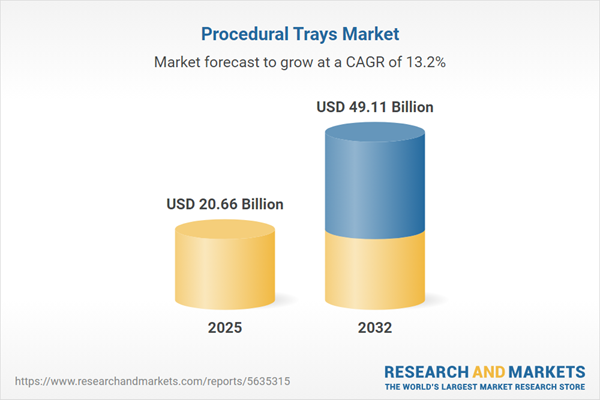Speak directly to the analyst to clarify any post sales queries you may have.
Senior healthcare leaders face critical decisions as the procedural trays market becomes more complex, demanding procurement strategies that address regulatory change, infection control, and supply chain efficiency. Focused, actionable intelligence is essential to maintaining compliance and operational stability in this evolving landscape.
Market Snapshot: Procedural Trays Market Size and Growth
The global procedural trays market is valued at USD 18.23 billion in 2024 and is projected to reach USD 20.66 billion by 2025. Long-term expectations suggest growth up to USD 49.11 billion by 2032, which equates to a compound annual growth rate of 13.18%. This expansion is shaped by continuous innovation in tray design, adoption of specialized equipment, and a need for compliance with evolving healthcare regulations. As care delivery adapts and infection control becomes central, procurement models are shifting to ensure robust supply, regulatory alignment, and operational improvement across healthcare environments.
Scope & Segmentation: Procedural Trays Market
This report provides extensive segmentation to help senior executives align procurement strategies with current and emerging market demands:
- Product Types: Disposable trays support stringent infection control, while reusable solutions cater to sustainability and cost-saving goals.
- Distribution Channels: Direct buying, distributor sourcing, and use of e-commerce platforms allow organizations to balance access, cost, and supply diversity in their procurement models.
- Material Types: Options like metal, molded fiber, paperboard, and plastics enable organizations to match tray composition with process requirements and sustainability objectives.
- Tray Sizes: A selection from small through extra-large allows flexible planning for diverse clinical use cases and variable patient volume needs.
- End Users: Hospitals, clinics, and nursing homes each necessitate tailored supply strategies reflecting patient throughput and care specialization.
- Geographic Regions: Analysis encompasses the Americas, Europe, Middle East and Africa, and Asia-Pacific, accounting for regional regulatory and procurement differences.
- Country-Level Insights: Focused profiles for the United States, Canada, Brazil, Germany, China, and India examine local regulatory environments and supply chain dynamics influencing procurement.
- Technology Adoption: Adoption of automated production, customizable configurations, and integrated digital inventory monitoring drives efficient processes and adaptation in supply management.
Key Takeaways for Decision-Makers
- Sustainability in procurement not only reduces long-term costs but reinforces supply chain continuity and aligns with environmental responsibilities.
- Digital inventory systems offer clear visibility and efficient resource distribution, while pre-empting the risk of product shortages or shipment delays.
- Customizable trays permit rapid adaptation to clinical process changes, supporting scalability amid variable patient admissions and unique care requirements.
- Diversified sourcing—including digital channels—strengthens supply chain flexibility and ability to withstand economic or regulatory disruptions.
- Close monitoring of regulatory policy shifts and budget variations ensures procurement remains agile, limiting compliance exposure.
- Automated processes and seamless cross-departmental integration facilitate transparency, helping teams collaborate and remain compliant across extensive healthcare networks.
United States Tariff Impact
In the U.S., healthcare systems are responding to shifting tariff conditions by strengthening domestic sourcing and investing in local manufacturing. These adjustments improve oversight of product supply, enhance responsiveness to regulatory updates, and lower vulnerability to international trade variability, all of which contribute to more reliable sourcing outcomes during times of global uncertainty.
Procedural Trays Market Research Methodology & Data Sources
This report relies on structured leadership interviews, targeted market surveys, frequent regulatory analysis, and expert peer panels. Together, these methodologies deliver actionable insights focused on the requirements of procurement and supply chain leadership.
Why This Report Matters: Procedural Trays Market
- Empowers senior leaders to anticipate regulatory shifts and refine procurement strategies for greater supply chain resilience.
- Offers frameworks for mitigating supply risk and building agile supplier networks, improving readiness for operational changes.
- Supports organizational stability and innovation through enhanced alignment between supply chain and healthcare operations.
Conclusion
This analysis helps healthcare executives optimize procurement, advance sustainability goals, and address compliance demands, securing efficient and consistent care delivery through steady access to procedural tray supplies.
Additional Product Information:
- Purchase of this report includes 1 year online access with quarterly updates.
- This report can be updated on request. Please contact our Customer Experience team using the Ask a Question widget on our website.
Table of Contents
3. Executive Summary
4. Market Overview
7. Cumulative Impact of Artificial Intelligence 2025
Companies Mentioned
The companies profiled in this Procedural Trays market report include:- Medline Industries, LP
- 3M Company
- STERIS plc
- Getinge AB
- Mölnlycke Health Care AB
- Johnson & Johnson
- Cardinal Health, Inc.
- Owens & Minor, Inc.
- B. Braun Melsungen AG
- Stryker Corporation
Table Information
| Report Attribute | Details |
|---|---|
| No. of Pages | 198 |
| Published | October 2025 |
| Forecast Period | 2025 - 2032 |
| Estimated Market Value ( USD | $ 20.66 Billion |
| Forecasted Market Value ( USD | $ 49.11 Billion |
| Compound Annual Growth Rate | 13.1% |
| Regions Covered | Global |
| No. of Companies Mentioned | 11 |









